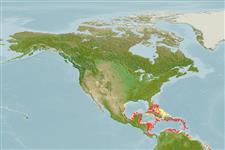Environment: milieu / climate zone / depth range / distribution range
Ökologie
seewasser demersal; tiefenbereich 1 - 5 m (Ref. 41041). Subtropical
Western Atlantic: Western Caribbean Sea and southern Gulf of Mexico.
Size / Gewicht / Alter
Maturity: Lm ? range ? - ? cm
Max length : 12.6 cm SL Männchen/unbestimmt; (Ref. 41041)
Rückenflossenstacheln (insgesamt) : 3; Rückenflossenweichstrahlen (insgesamt) : 23 - 26; Afterflossenweichstrahlen: 20 - 22; Wirbelzahl: 32 - 35. Narrow interorbital distance (29-65 thousandths of SL), usually less than the diameter of the orbit (60-104 thousandths of SL), versus usually equal to or wider than the orbit diameter in other Opsanus species. Similar to O. phobetron, both usually have the posterior part of lower half of the mouth darkly pigmented in specimens over 7 cm SL. Upper lateral-line papillae 26, lower 23. Pectoral fin glands 12, starting between uppermost 2 pectoral fin-rays (Ref. 41041).
Life cycle and mating behavior
Geschlechtsreife | Fortpflanzung | Ablaichen | Eier | Fecundity | Larven
Collette, B.B., 2001. Opsanus dichrostomus, a new toadfish (Teleostei: Batrachoididae) from the western Caribbean Sea and southern Gulf of Mexico. Occas. Pap. Mus. Zool. Univ. Mich. (731):1-16. (Ref. 41041)
IUCN Rote Liste Status (Ref. 130435: Version 2024-1)
Bedrohung für Menschen
Harmless
Nutzung durch Menschen
Tools
Zusatzinformationen
Download XML
Internet Quellen
Estimates based on models
Preferred temperature (Ref.
123201): 26.6 - 28.3, mean 27.5 °C (based on 256 cells).
Phylogenetic diversity index (Ref.
82804): PD
50 = 0.5312 [Uniqueness, from 0.5 = low to 2.0 = high].
Bayesian length-weight: a=0.00468 (0.00180 - 0.01212), b=3.12 (2.90 - 3.34), in cm total length, based on LWR estimates for this (Sub)family-body shape (Ref.
93245).
Trophic level (Ref.
69278): 3.5 ±0.6 se; based on size and trophs of closest relatives
Widerstandsfähigkeit (Ref.
120179): hoch, Verdopplung der Population dauert weniger als 15 Monate. (Preliminary K or Fecundity.).
Fishing Vulnerability (Ref.
59153): Low vulnerability (10 of 100).
